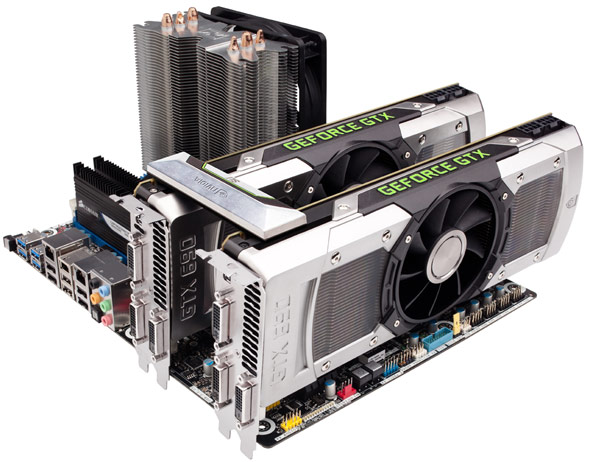GeForce GTX 690 Review: Dual NVIDIA GK104 GPUs
Intro, Specifications and Related Info
According to a few folks we spoke to at NVIDIA, company CEO Jen Hsun Huang told the team to spare no expense and build the best graphics card they possibly could, using all of the tools at their disposal. The result was obviously the GeForce GTX 690, but in building the card, the team at NVIDIA employed a number of new components and materials that set the card apart from the company’s previous dual-GPU powered offerings. In addition to a pair of GK104 GPUs and 4GB of GDDR5 RAM, the GeForce GTX 690 features laser etched lighting, a magnesium fan housing, and a plated aluminum frame, along with a dual vapor chamber cooler design with ducted airflow channels and tuned axial fan. The sum total of all of these things result in not only NVIDIA’s fastest graphics card to date, but also one of its quietest.
We’ve only had a GeForce GTX 690 in our possession for a few days now, but they begin shipping in limited quantities today. So we put our evaluation efforts into high gear and cranked out this article in record time so that the lucky few that can afford this beast know exactly what they are getting...

Dual GeForce GTX 690 Cards in a Quad-SLI Configuration. An easy 11 on the Geek Porn-o-Meter
|
| Processing Units | |
| Graphics Processing Clusters | 8 |
| SMXs | 16 |
| CUDA Cores | 3072 |
| Texture Units | 256 |
| ROP Units | 64 |
| Clock Speeds | |
| Base Clock | 915 MHz |
| Boost Clock | 1019 MHz |
| Memory Clock (Data Rate) | 6008 MHz |
| L2 Cache Size | 1024KB (512KB per GPU) |
| Memory | |
| Total Video Memory | 4096MB GDDR5 (2048MB per GPU) |
| Memory Interface | 2 x 256-bit |
| Total Memory Bandwidth | 384.4 GB/s (192.2 GB/s per GPU) |
| Texture Filtering Rate (Bilinear) | 234.2 GigaTexels/sec |
| Physical & Thermal | |
| Fabrication Process | 28 nm |
| Transistor Count | 7.08 Billion |
| Connectors | 3 x Dual-Link DVI, 1 x mini-DisplayPort |
| Form Factor | Dual Slot |
| Power Connectors | 2 x 8-pin |
| Recommended Power Supply | 650 watts |
| Thermal Design Power (TDP) | 300 watts |
| Thermal Threshold | 98° C |
Leading up to this launch, NVIDIA had a little fun with a few members of the tech press. A couple of weeks back, the company sent some pry bars out to members of the press with “For Use In Case of Zombies Or...” laser etched into the bars’ surface, adjacent to an NVIDIA claw logo. Well, when our GeForce GTX 690 arrived we found out exactly what those pry bars were for...
As you can see, the GeForce GTX 690 arrived in some rather unique packaging. The card arrived encased in a wooden crate, branded with a cautionary warning that some “weapons grade gaming power” was enclosed within. Needless to say, that pry bar came in mighty handy, because you know we didn’t waste any time ripping that GTX 690 from its box and installing it in our test system.
Before we give you the low-down on the GeForce GTX 690 though, we want to direct your attention to a few other HotHardware articles related today's launch...
- NVIDIA GeForce GTX 680 Review: Kepler Debuts
- NVIDIA 3D Vision 2 and The Asus VG278H LCD Review
- NVIDIA GeForce GTX 590: Dual GF110s, One PCB
- NVIDIA 3D Vision Surround is Here
We've already covered the details of the GK104 GPU powering the GeForce GTX 690 in our GeForce GTX 680 launch article, including things like GPU Boost, NVENC, and TXAA, so we won't go over them again here. If you'd like a deeper look into the technologies employed in the GK104, we'd definitely suggest taking a gander at our GTX 680 coverage. The details of NVIDIA's previous-gen dual-GPU flagship are covered in our GeForce GTX 590 article, and our 3D Vision 2 and 3D Vision Surround articles cover those two NVIDIA technologies, which are obviously supported in a card like the GeForce GTX 690.






